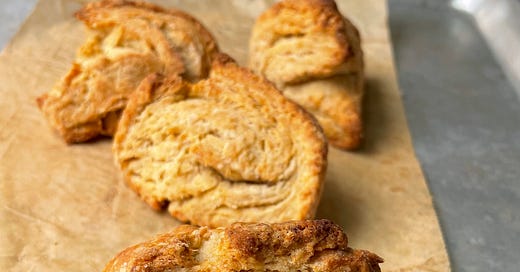There’s something about spring that makes me crave a fresh, buttery, flaky scone. I’m convinced most people haven’t had a good scone, which is a shame. Too often, they’re dry, overly sweet, or have a muffin-like texture. Some are as hard as rocks or just plain bland. These scones? They’re none of that. They’re flaky, perfectly crumbly, just the right amount of sweetness, and lean more biscuit-like, which is exactly how I like them. My discerning scone standards come from months of hunting down the best ones I could find in and around Ithaca (a pastime I picked up in college during the pandemic). Trumansburg Main Street Market and Gimme Coffee are my top picks, if you’re wondering.
Now, about small batch baking. As much as I love to bake, I don’t want to be stuck with a ton of the same treat at once. I know I can freeze extras, but freezer space is precious in a tiny NYC apartment. I’d rather bake just a few and enjoy them without feeling like I have to power through a mountain of the same thing. This small batch recipe makes 4 modest scones—just the right amount for a couple of breakfasts or afternoon tea breaks throughout the week. They’re actually made with a bit of full-fat Greek yogurt, instead of the usual heavy cream, which I almost never buy because I’m not a fan of buying an ingredient that I’ll only use for one purpose. Whole milk yogurt works beautifully to add a bit of moisture without disrupting the buttery flakes.
Many baking recipes are designed for larger batches, which can make scaling them down a bit tricky. I prefer to start by identifying the hardest ingredient to divide (usually eggs) and adjust it to the smallest whole number. For example, if a recipe calls for 3 eggs, I divide the entire recipe by 3 so I don’t need to measure fractions of an egg. Ingredients like flour, sugar, and other dry ingredients are much easier to figure out, especially if you’re using a kitchen scale.
This is a basic scone recipe that’s infinitely adaptable. It’s plain on purpose, but feel free to customize however you like. I often add lemon zest or toss in dried cherries. Just be mindful that fresh fruit will release moisture as it bakes, which will make the scones less flaky and more muffin-like. Still delicious, though!
Before we get into the recipe, here are my 2 top scone tips:
Cold butter is key. Cold butter creates those beautiful flaky layers. If the butter starts to soften while you’re working, don’t fret. Just pop the dough in the fridge for a few minutes to chill and then continue.
Don’t over-mix. This is the difference between a good scone and a terrible one. Mix the dough until just combined—no more.
Keep reading with a 7-day free trial
Subscribe to What's Cooking to keep reading this post and get 7 days of free access to the full post archives.




